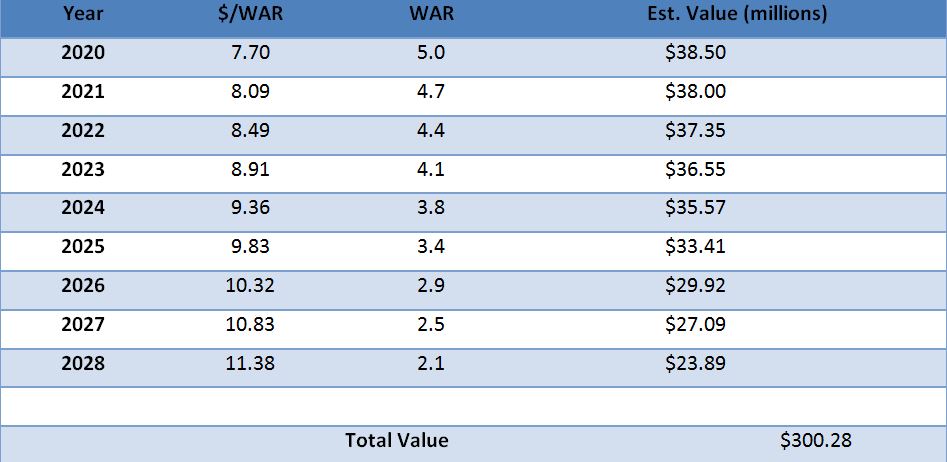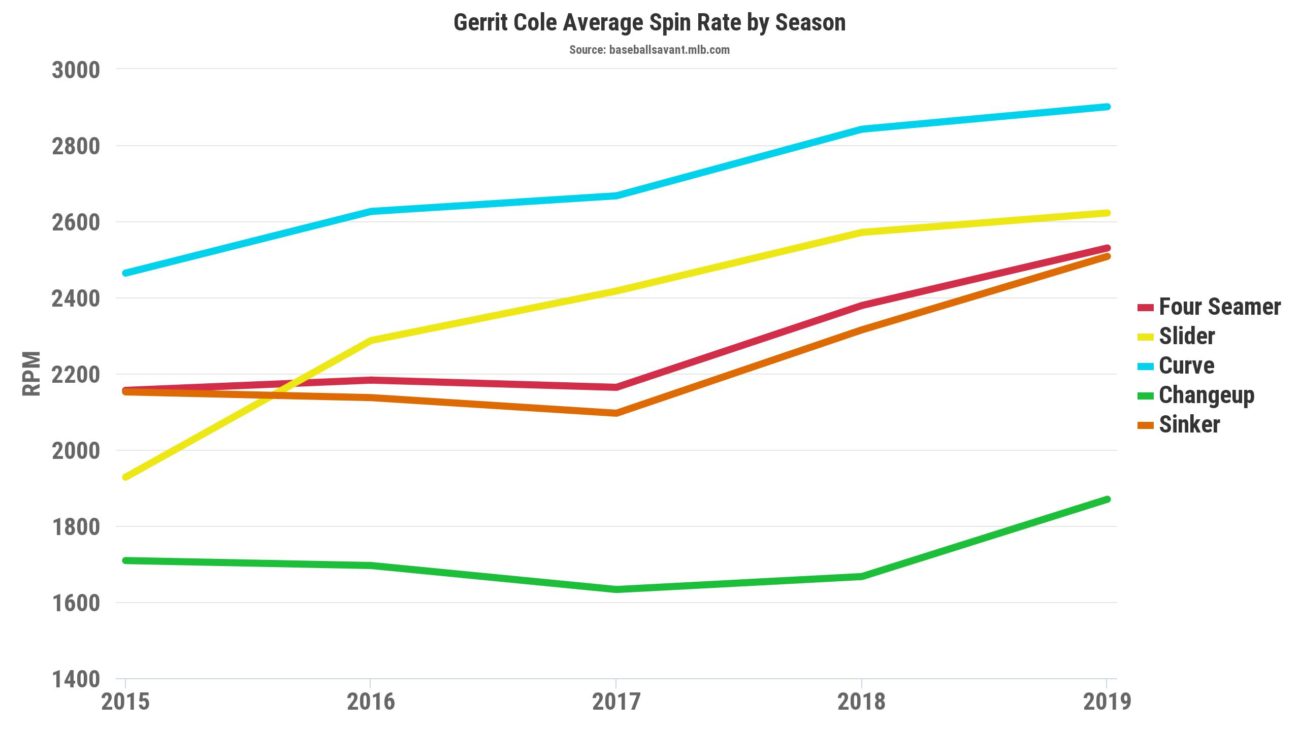After 11 years of trying, the Yankees finally got Gerrit Cole! He now joins Luis Severino, Masahiro Tanaka, and James Paxton in what is assuredly one of, if not the best, rotations in all of baseball.
Whenever the Yankees make a big deal, the immediate fan reaction goes to “this bum’s overpaid, and he’s blowing up the payroll.” Earlier, Milan wrote about why that won’t be the case for Cole. To further that analysis, I’m going to look at the various projection systems and come up with Gerrit Cole’s estimate worth over the next 9 beautiful seasons that he will call the Bronx home.
ZiPS
ZiPS is short for sZymborski Projection System, named after its founder Dan Szymborski. This system uses “growth and decline curves based on player types to find trends,” and it uses stats from the previous four years. The system develops a projected stat line for the player which is then factored into a wins above replacement (WAR) formula. Then, you multiple the WAR by how much a win is worth for that season.
Szymborski estimates 1 win in 2020 is worth $7.7 million, and until Dan is able to get some sleep, I don’t really know why. But he’s a hell of a lot smarter than I am so I’ll take his word for it. Each year as revenues in baseball increase, the value of 1 win goes up by 5%. I know that all sounds confusing, so let’s look at it in table form.
So from this analysis, it looks like the Yankees overpaid by $24 million, which is $2.7 million per year. But, there are several reasons not to think it’s that simple. First, like I said above, ZiPS uses the past 4 seasons of data. That includes Cole’s last two years with the Pirates before he went to Houston and reinvented himself. This chart shows how he shelved his sinker in favor of the fourseam fastball when he got to Houston:
You can see the clear uptick in fourseam usage starting in 2018, coinciding with the reduced sinker usage. That change has made a huge difference for Cole.
The Astros also unlocked his spin rate potential. This chart shows his spin rate for all his pitches by season:
An increased spin rate for fourseam fastballs and breaking balls is almost always a good thing, and Cole is among the league leaders in spin rate for both of those pitch types. Those changes are what led to Cole transforming into the Cy Young caliber pitcher he is. In the two seasons prior to joining Houston, Cole was worth a combined 5.9 WAR. He surpassed that total in 2018 alone with a 6.0 WAR and destroyed it in 2019 with a 7.4 WAR. ZiPS weights recent seasons more, but it is still using those poor 2016 and 2017 seasons for its calculations which do not reflect who Cole is today with those significant pitch changes.
Oliver Projections
The Oliver projections were created by Brian Cartwright and are often used by MLB.com. This system uses the past 3 seasons (not 4 like ZiPS) as well as age and regression to develop its projections. Their projection is more optimistic for Cole, and believes Cole’s ERA over the next 7 years will go like this:
2020: 2.57
2021: 2.56
2022: 2.59
2023: 2.66
2024: 2.75
2025: 2.82
2026: 2.92
Compare that to ZiPS, which believes Cole’s ERA next year will be 3.11. In the past 7 seasons, no pitcher has had an ERA under 3.00 each year. Max Scherzer and Clayton Kershaw came the closest, reaching that milestone 6 out of the 7 years. This projection helps show just how good of a pitcher Cole is and that he might just be the best free agent pitcher ever.
Tom Tango converted those projections to WAR so we can calculate monetary value based on the projection.
That looks a lot better! For the last two seasons of the deal, I used the ZiPS WAR projection. Using this model, Cole will be worth $337 million, which is right around where the contract is. So, if Cole lives up to the hype and remains one of the best pitchers in baseball, he will absolutely be worth the contract.
Steamer System
The last system we’re going to take a look at is the Steamer Projections, which FanGraphs updates every day. The way this one works is we have the projection for 2020. For future years, I deducted 0.5 WAR per season which is the estimate of a standard aging curve.
Wow! By this projection, the Yankees will actually come out way ahead. So when that guy (and there’s always that guy) tries to tell you the Yankees buy their championships and overpaid, you can show them the math and prove them wrong.
Conclusions
Whenever we’re talking about projections, it’s important to remember projections are not predictions. Nobody knows what Cole is going to do over the length of his contract. The models take into account Cole’s past performance and the performance of other past pitchers, which is why we can use these numbers with some confidence.
There is inherent variability between the models because they project things differently. The main thing I found here is ZiPS uses the past 4 years of data for a player of Cole’s age whereas Oliver and Steamer use the past 3 years. For most players, more data is better. However, for Cole I have more confidence in the projections that only use the past 3 years to project because of the changes he made 2 years ago in Houston.
Not to mention, this is the New York Yankees we’re talking about. They have by far the highest revenue in baseball – hundreds of millions more than any other team. They are more equipped to have these long term mega contracts than any team in baseball. As someone who has written extensively on their need to flex their financial muscle, I am both relieved and beyond excited they backed up the Brinks truck for Cole.
Any way you look at it, the Yankees got a great pitcher and it’s going to be a lot of fun watching Cole throw this nastiness for the next several years.
Gerrit Cole's Arsenal
4 Pitch Overlay (all from K pitches yesterday).
Red: 100mph Fastball
Green: 90mph back foot Slider
Blue: 84mph Knuckle Curve
Yellow: 88mph Changeup pic.twitter.com/eQJ4MyFixv— Rob Friedman (@PitchingNinja) September 3, 2019
Check out the newest Cole/Bronx Pinstripes merch below. LET’S GO!
We got our ACE!! LET’S GOOOOOO!!!!!
IT’S A COLE WORLD!! #YANKEES
📲 https://t.co/WSAeeqc3rl pic.twitter.com/0cUfFDsaKW
— Bronx Pinstripes (@BronxPinstripes) December 11, 2019
You can contact Rohan on Twitter @rohanarcot20









